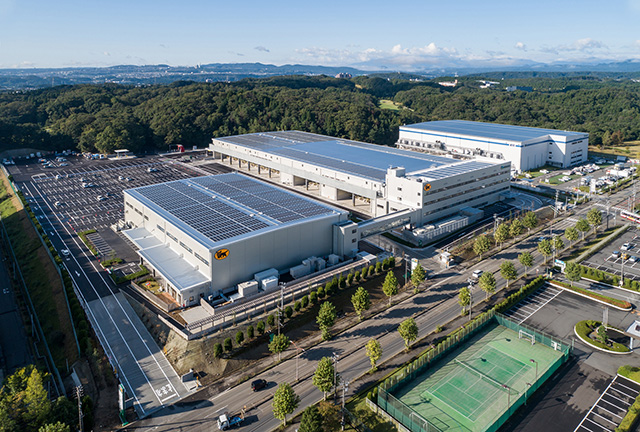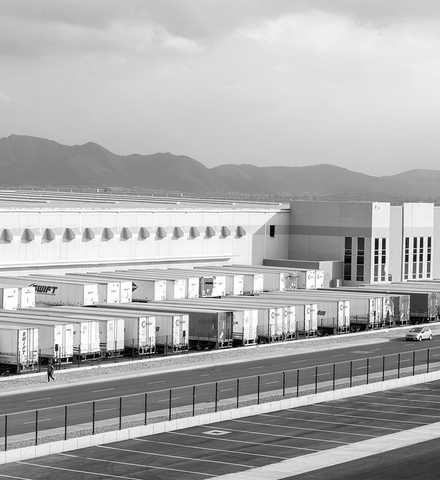
- The Industrial Business Indicator (IBITM) Utilization Rate increased to 85.3% in January after averaging 84% in Q4. Several factors lowered space utilization through year-end:
- Strong holiday sales reduced warehouse inventories more quickly than they were replenished, resulting in empty racks.
- Sublease availability remains above historical norms, reflecting persistent excess capacity in some locations.
- The IBI Activity Index hit 59.9 in January after averaging 59 in Q4. Levels in the high 50s/low 60s are consistent with a strong flow of goods through U.S. warehouses, which was exhibited by 3.5% year-over-year growth in retail goods salesi and an estimated 15% to 20% year-over-year growth in import volumes.ii
- The U.S. industrial market is close to the bottom of the current supply driven mini-cycle, with vacancies peaking.iii Looking ahead, completions should decline by more than 35% in 2025, putting downward pressure on the vacancy rate.
- Rents declined 2% during Q4 after falling 3% in Q3.iv Looking ahead, we expect rents to rise again around mid-2025 in most U.S. markets.
The IBI Utilization Rate increased to 85.3% in January after remaining below the normal expansionary range in Q4. Strong consumption continued to outpace growth in inventories, pulling down utilization during the holidays. Excess capacity remains, however, reflected by a utilization rate below 85.5% and sublease availabilities above 1%.iii
Customers report they are growing into existing capacity, supported by January increases in both the Utilization Rate and the IBI Utilization Index, which asks if customers are using space. At the same time, the IBI Activity Index reflected elevated throughput, averaging an expansionary reading of 59 during 2024 and inching up to nearly 60 in January.
U.S. industrial real estate leasing activity accelerated after the presidential election. Net absorption was positive, but muted through 2024, but early signs of demand diversification surfaced across industries, markets, and size categories during Q4.iii
- Leasing grew in key industries with notable expansion in e-commerce, fast-moving consumer goods, and food and beverage companies.iii
- Demand was robust across the sunbelt—from Las Vegas and Phoenix on one side through Texas and into the Southeast and Florida on the other. Activity broadened over the course of Q4 in other geographies, such as Toronto and the mid-Atlantic, including New Jersey and Pennsylvania.iii
- Big-box demand drove most net absorption over the course of 2024, but Q4 saw the highest new absorption in more than 18 months for facilities below 250,000 square feet.iii
The shift in market conditions is fueled by a marked change in the supply backdrop. New deliveries fell by 38% year-over-year in 2024iii while a sizeable gap between replacement cost rents and market rents produced a challenging environment for speculative development. New building starts fell nearly 40% year-over-year in 2024.iv As a result, completions are poised to fall by another 35% in 2025, allowing vacancy rates to decrease later in the year as new supply falls short of new demand.iii
Rents are expected to rise later in 2025 with signs of growth already emerging in select markets. Rent growth varied widely by market in 2024 with Southern California again recording the most pronounced decreases. Outside the West, rents remained largely resilient with several markets posting positive rent growth heading into 2025.
Conclusion
The industrial real estate market continues to progress through a mini-cycle, with vacancy rates peaking as occupiers move cautiously to expand supply chain networks. Proposals and leasing activity reflect early signs of a post-election shift as greater certainty prompts decision-making. This momentum plays into our expectations for a 20% annual increase in net absorption for 2025 with velocity increasing as the year progresses. Vacancy rates should decline alongside a 35% reduction in new completions.iii The market remains favorable to occupiers in the near term before conditions tighten through the year.
Methodology
The Prologis Industrial Business Indicator (IBI) is derived from a survey of Prologis customers on their warehouse activity and utilization. Respondents classify activity as “Weaker,” “Same,” or “Stronger,” relative to the prior month and these answers are combined into a diffusion index ranging from 0 to 1. Similarly, respondents classify space utilization as “More,” “Same,” or “Less,” relative to the prior month and these answers are combined into a diffusion index ranging from 0 to 1. The utilization rate is reported as an average percentage, reflecting how fully respondents are using their available warehouse space.


